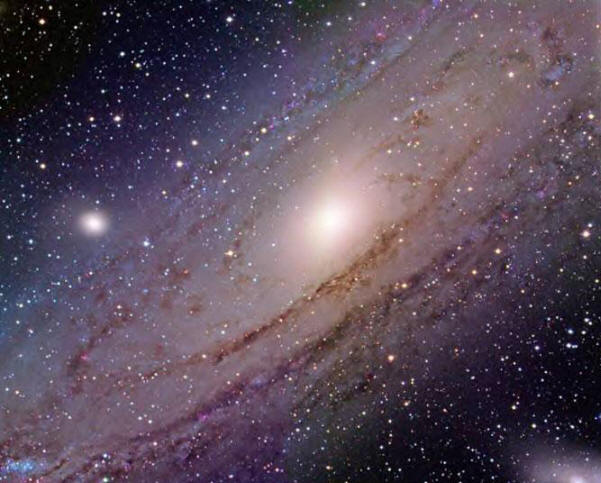
home •
about •
essential guide •
picture of the day •
thunderblogs •
news •
multimedia •
predictions •
products •
get involved •
contact
picture of the day archive subject index
The Andromeda galaxy in infrared and in x-ray light (blue).
Credits: AAAS/Science with ESA XMM-Newton and NASA Spitzer data.
Jul 23, 2008
Dark Matter-Dark CurrentsIn his now-famous 1962 essay, The Structure of Scientific Revolutions, Thomas Kuhn proposed that the common idea of scientific progress as a continuous, albeit bumpy, approach toward the truth or toward reality failed to explain particular historical episodes that were discontinuous.
Kuhn wrote, "[S]cience has included bodies of belief quite incompatible with the ones we hold today." These beliefs were "produced by the same sorts of methods and held for the same sorts of reasons" as are today's beliefs. And this "makes it difficult to see scientific development as a process of accretion."
He goes on to describe "revolutions" in science, and he notes that theories on opposite sides of a revolution are "incommensurable." Because the worldview of a theory colors the facts, selects the problems to be solved, and defines the acceptability of solutions, there are no scientific criteria to justify judging one theory to be closer to the truth than another.
Nevertheless, scientists do judge one theory to be "more true" than another. At times of revolution, this judgment is transferred from an accepted theory to a novel theory, and pieces of the old theory are reinterpreted in the light of the new worldview to be precursors to the new more true theory.
What are overlooked are non-scientific criteria for choosing one theory to be more apt or useful with respect to evolving goals and cultural conditions. While theories cannot legitimately be judged by the standards of another theory, they can be compared with respect to the problems, performance, and promise of each one judged by its own standards.
This is the same kind of judgment that a cook uses in the produce department when deciding whether to buy turnips or asparagus. The facts, the problems, and the potential solutions are incommensurable among theories, but scientists' interest and curiosity, shaped by the surrounding conditions of life in a particular time and place, lead them to decide among the offerings.
Recourse, then, is not to facts or to compatibility with some "already known" but to differences in vision and promise. This series of Pictures of the Day will contrast such differences between presently accepted theories and Electric Universe theories.
The image above is of the nearby spiral galaxy in Andromeda. From the viewpoint of gravity theories, what you don't see is more important than what you do. A black hole at the center of the galaxy pulls in matter and squeezes it until it explodes with a superabundance of radiation. A halo of dark matter surrounds the galaxy and causes the stars in the spiral arms to revolve at the same velocity. The quasars, small galaxies, and gas clouds that stretch out along the rotation axis far from the galaxy are coincidental alignments of background objects. The blue shift of the galaxy indicates that it is moving toward us.
From the viewpoint of an Electric Universe, what you don't see also is important. A plasma focus mechanism at the center pulls in current and squeezes it until it explodes in a superabundance of radiation. The pinch effect in plasma currents causes filaments to form, and these you can see. A persistent current can only exist in a circuit, so the spiral arms are "feeder" currents that complete the circuit to the center.
These currents are in "dark mode" and therefore are invisible, like dark matter. But unlike dark matter, dark mode currents can be investigated in a lab. Lab dark currents are a source of copious microwave radiation; so, the cosmic microwave background radiation, which the Big Bang theory identifies as a distant remnant of its secular "Genesis story," is likely a microwave "fog" generated locally by the web of currents in our own galaxy's spiral arms.
Because these currents are also subject to the pinch effect and to concomitant instabilities, stars (cosmic ball lightning) form along them. Since electrical forces, not gravity, drive them, they all have the same velocity. The plasma focus at the center repeatedly discharges its accumulating charge by ejecting blobs and streams of plasma along its spin axis.
Because the electrical stress among these blobs varies in a resonant, step-wise manner, their radiation shows a quantized variation of redshifts. The blueshift of the galaxy, one quantum step from the sequence of redshifts that ends with the Milky Way at zero, indicates that the Milky Way may be one of the first objects ejected from the Andromeda galaxy.
__________________________________________________________________________
Please visit our new "Thunderblog" page
Through the initiative of managing editor Dave Smith, weve begun the launch of a new
page called Thunderblog. Timely presentations of fact and opinion, with emphasis on
new discoveries and the explanatory power of the Electric Universe."The Electric Sky and The Electric Universe available now!

|
|

|
EXECUTIVE EDITORS:
David Talbott, Wallace Thornhill
MANAGING EDITORS:
Steve Smith, Mel Acheson
CONTRIBUTING EDITORS: Michael Armstrong, Dwardu Cardona,
Ev Cochrane,
C.J. Ransom, Don Scott, Rens van der Sluijs, Ian Tresman
WEBMASTER: Brian Talbott
Copyright 2007: thunderbolts.info
![]()
home
thunderblogs
forum
picture of the day
resources
team
updates
contact us

